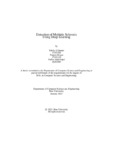| dc.contributor.advisor | Alam, Md. Ashraful | |
| dc.contributor.author | Jannat, Sabila Al | |
| dc.contributor.author | Hoque, Tanjina | |
| dc.contributor.author | Supti, Nafisa Alam | |
| dc.date.accessioned | 2021-12-22T06:31:04Z | |
| dc.date.available | 2021-12-22T06:31:04Z | |
| dc.date.copyright | 2021 | |
| dc.date.issued | 2021-01 | |
| dc.identifier.other | ID 17101302 | |
| dc.identifier.other | ID 17101129 | |
| dc.identifier.other | ID 16201083 | |
| dc.identifier.uri | http://hdl.handle.net/10361/15737 | |
| dc.description | This thesis is submitted in partial fulfillment of the requirements for the degree of Bachelor of Science in Computer Science and Engineering, 2021. | en_US |
| dc.description | Cataloged from PDF version of thesis. | |
| dc.description | Includes bibliographical references (pages 21-23). | |
| dc.description.abstract | Accurate detection of white matter lesions in 3D Magnetic Resonance Images (MRIs) of patients with Multiple Sclerosis is essential for diagnosis and treatment evaluation of MS. It is strenuous for the optimal treatment of the disease to detect early MS and estimate its progression. In this study, we propose efficient Multiple Sclerosis detection techniques to improve the performance of a supervised machine learning algorithm and classify the progression of the disease. Detection of MS lesions become more intricate due to the presence of unbalanced data with a very small number of lesions pixel. Our pipeline is evaluated on MS patients data from the Laboratory of Imaging Technologies. Fluid-attenuated inversion recovery (FLAIR) series are incorporated to introduce a faster system alongside maintaining readability and accuracy. Our approach is based on convolutional neural networks (CNN). We have trained the model using transfer learning and used softmax as an activation function to classify the progression of the disease. Our results significantly show the effectiveness of the usage of MRI of MS lesions. Experiments on 30 patients and 100 healthy brain MRIs can accurately predict disease progression. Manual detection of lesions by clinical experts is complicated and time-consuming as a large amount of MRI data is required to analyze. We analyze the accuracy of the proposed model on the dataset. Our approach exhibits a significant accuracy rate of up to 98.24%. | en_US |
| dc.description.statementofresponsibility | Sabila Al Jannat | |
| dc.description.statementofresponsibility | Tanjina Hoque | |
| dc.description.statementofresponsibility | Nafisa Alam Supti | |
| dc.format.extent | 23 pages | |
| dc.language.iso | en | en_US |
| dc.publisher | Brac University | en_US |
| dc.rights | Brac University theses are protected by copyright. They may be viewed from this source for any purpose, but reproduction or distribution in any format is prohibited without written permission. | |
| dc.subject | Magnetic Resonance Imaging(MRI) | en_US |
| dc.subject | Machine Learning | en_US |
| dc.subject | Multiple Scle- rosis(MS) | en_US |
| dc.subject | 3D Magnetic Resonance Imaging | en_US |
| dc.subject | White Matter Lesion Detection | en_US |
| dc.subject | Deep Learning | en_US |
| dc.subject | Convolutional Neural Network(CNN) | en_US |
| dc.subject | Fluid-attenuated inversion recovery (FLAIR) | en_US |
| dc.subject | Data Augmentation | en_US |
| dc.subject | Image Processing | en_US |
| dc.subject.lcsh | Machine Learning | |
| dc.title | Detection of multiple sclerosis using deep learning | en_US |
| dc.type | Thesis | en_US |
| dc.contributor.department | Department of Computer Science and Engineering, Brac University | |
| dc.description.degree | B. Computer Science | |

